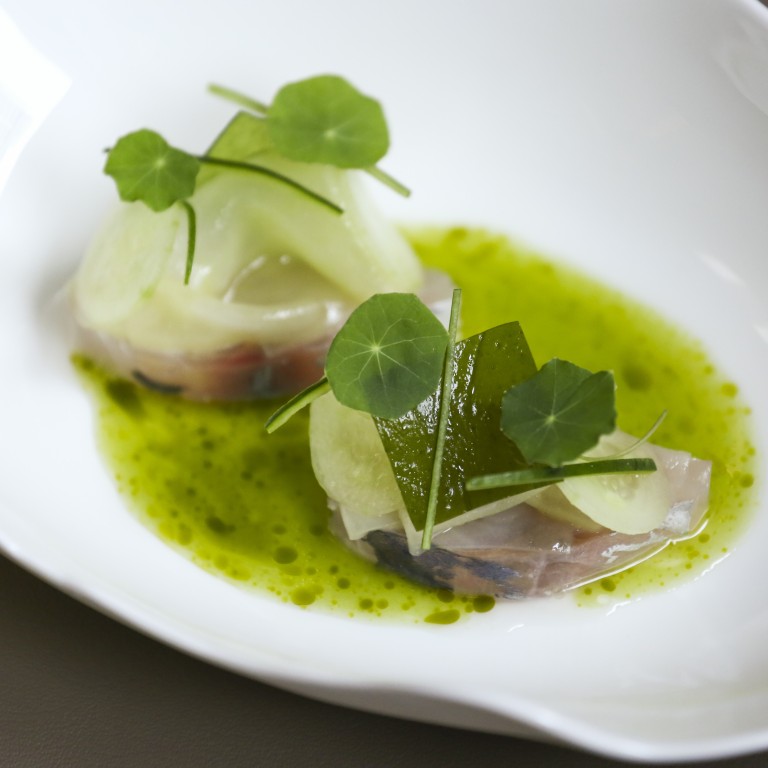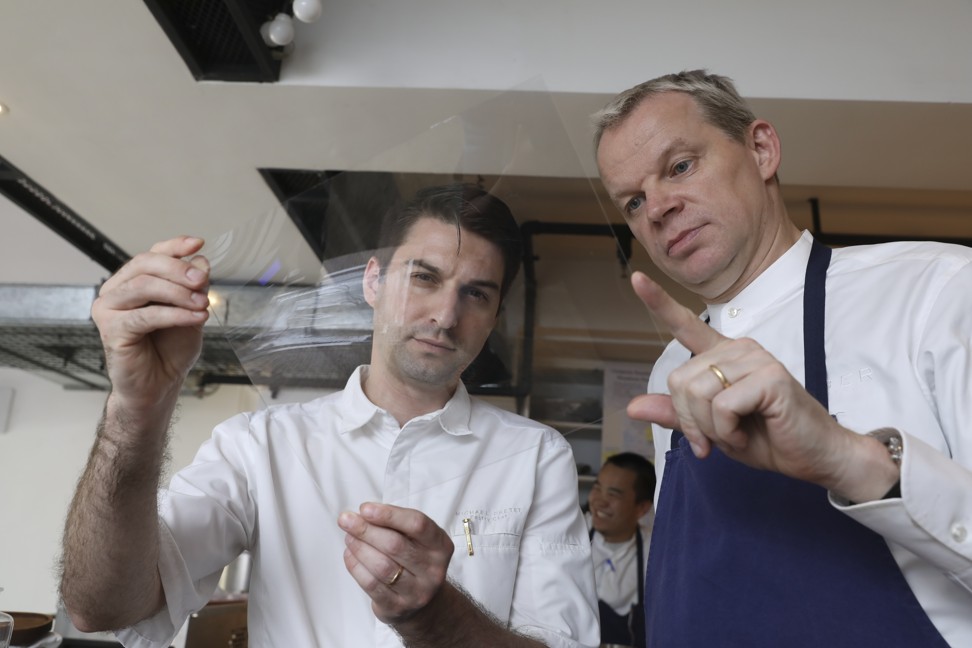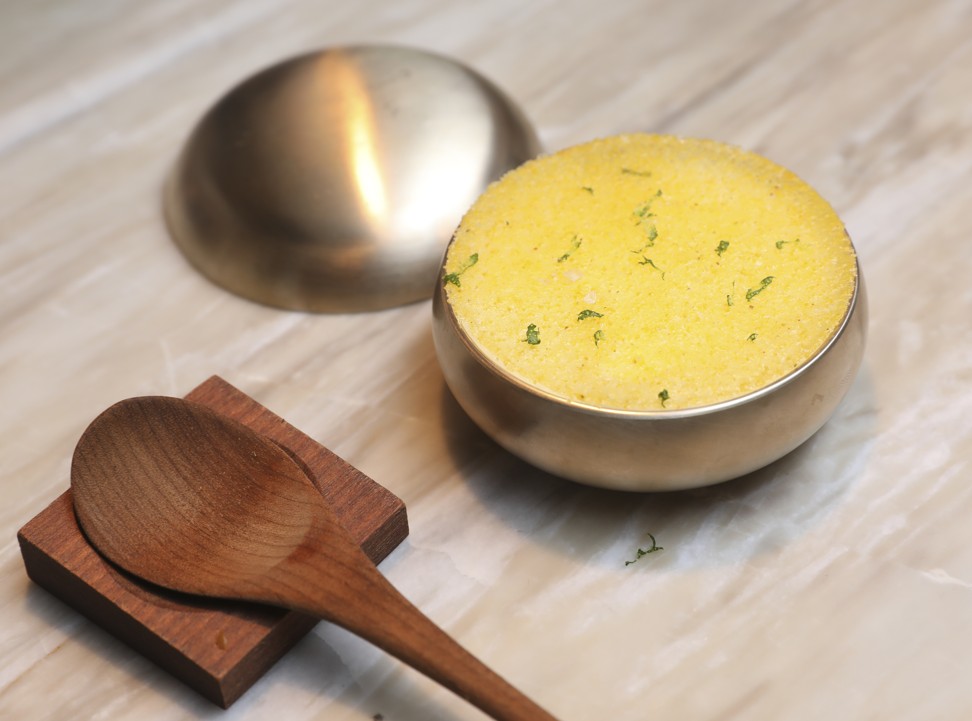
Michelin-star restaurant Amber redefines French food with dairy-free menu as part of revamp
- Hong Kong two-Michelin-star restaurant reopened this week with new decor, a new menu and a bold new culinary philosophy
- In place of dairy products, chefs use cold-pressed, plant-based oils and ‘milks’ made from soy, nut and rice
Chef Richard Ekkebus has a long list of dogmas that he and his kitchen team will be following with the much anticipated relaunch of Amber, the Landmark Mandarin Oriental’s two-Michelin-star European fine-dining restaurant.
The Hong Kong restaurant reopened on Thursday, after closing its doors in early December for a complete renovation.
“No sous-vide,” he says, referring to the popular technique where food is vacuum-sealed in a plastic bag then cooked in a water bath set to a precise temperature (its detractors compare it to “boil in a bag” meals).
“No more squeeze bottles – well, wherever possible, anyway – we’re still working on that. The pastry chef still likes his squeeze bottles.”

But what is most surprising is when the Dutchman – the hotel’s culinary director and Amber’s executive chef since it opened in 2005 – states firmly, “No more dairy.”
What? How can a top European restaurant function without butter, cream or milk?
Seaweed extract, gum replace eggs, animal fats at World Pastry Cup
“When I eat in most [European] restaurants these days, I have trouble finishing a 12- to 14-course tasting menu. I struggle with the heaviness. But I don’t have that problem when I travel through Japan or China; there’s a lightness to the cooking in Asia that we have never integrated within Western cooking,” he says.
“When I was a kid [in the Netherlands] I grew up eating 200 grams of cheese and a litre of milk every day. My father still eats about a kilo of salted butter a week – he’s 80 and is super fit, but his metabolism allows him to do this. But the world is changing, people are changing, our needs are changing. And in Asia, most of the population is lactose intolerant because dairy is not part of the Asian staple diet.
“We’ve been looking into how we can replace dairy; we were working on it for probably the last 12 months at Amber – we started to gradually eliminate dairy in our food. In the last days of Amber, there was almost no dairy. We don’t want to deprive anyone, Amber will still be a place for celebration, a special occasion restaurant. But I want people to leave Amber feeling much better than they might when they leave a more traditional type of French restaurant.”

Ekkebus, who is also a certified nutritionist, explains that in place of the dairy products that many chefs rely on to give richness to dishes, they’ll be using cold-pressed, plant-based oils, as well as some ingredients that are rarely found in European Michelin-starred kitchens: soy, nut, rice and cereal-based “milks” – all made in-house.
“About a year and a half ago we made a dessert for someone who was lactose intolerant and glucose intolerant. We made a chocolate dessert, and it was so good, I was so surprised. Normally, when you use chocolate and add butter or cream, you end up with milk chocolate. But if you add tofu, you have a cleaner flavour profile.
“All of these experiments have shaped the way I see food moving forward. Everyone is moaning about all sorts of allergies, and instead of fighting it, I think we need to embrace it and let it direct us into a new way of cooking.”

If he hadn’t pointed it out, I would never have noticed the lack of butter and cream in the nine dishes the Amber chefs prepared for me at Test Kitchen in Sai Ying Pun, which the team was using for a month before the Amber kitchen was ready. The walls of their temporary kitchen are completely covered with lists, recipes, and ideas they’re working on (and most of the table spaces are covered with the new plates and cutlery for the restaurant).
I taste a bright, light silken tofu with lacto-fermented tomato juice, Fukuoka tomatoes, sakura salt, sakura leaves and almond oil, followed by a delicious, salt-free raw fish dish of horse mackerel that’s been cured with kombu (which adds umami), served with dashi gel made from the fish trimmings (“we’re trying not to waste anything,” says Ekkebus), celtuce, seaweed, cucumber and a bright green wheatgrass sauce.
Probably most surprising is the indulgent but cream-free corn custard with a freeze-dried corn tuile, a generous amount of caviar that is then topped with whipped soy, seaweed and seawater foam.

“This is a technique that’s new to us,” says Ekkebus. “There’s a lot of starch in corn – that’s why they make cornstarch. So we make a cold-pressed juice of fresh Okinawa corn, then we cook it very slowly on the stove. It’s pure juice – no flour, no egg, no cream, and it thickens into a custard without anything added. It has a very creamy, sweet, natural and clean taste.”
The dishes – a selection taken from the different five- to seven-course tasting menus that Ekkebus has created – will be served in an entirely new Amber.
The seventh-floor space that once housed just Amber, the bar and private rooms now has Amber, Somm (serving French “neo-bistro” dishes with wines and sake), the three-Michelin-star Sushi Shikon (which was previously in Sheung Wan) and the more casual Japanese concept, Kappo Rin.

The new Amber has more tables for couples, and gone is the restaurant’s distinctive showpiece of 4,320 long bronze rods hanging from the ceiling.
“When we started talking about the Amber [renovation] project four years ago, we agreed the most important thing is to understand the customer of tomorrow,” Ekkebus says. “We did focus groups to understand the state of fine dining and to get fresh insights into what the customer wants. One of the most important things we learned was about acoustics – very important in fine-dining restaurants. We worked with an acoustics specialist and [designer] Adam Tihany to make sure we got that right.

“We wondered if we should keep the brass rods, because they’re associated with Amber, then we decided to get rid of everything because people would be thinking, ‘Well, something has changed – new chairs, new carpets, but it’s still the same Amber’. If we wanted to write a new story, we needed to have a clean canvas.”
Snap-happy diners will be pleased to see that the lighting has improved. “We have a lighting consultant,” says Ekkebus. “That was actually my biggest problem in the old Amber – there was always an awful brown-yellow glow on the food, and we wanted to make sure that we had light that was photo-friendly.”
The kitchen, too, is completely different, able to comfortably accommodate the larger team of cooks (up to 72, from a previous 53), with new stoves, and hi-tech equipment that includes a 3D printer and vacuum mould makers.

But why did they want to toy with success in the first place?
“Amber has always been a forward thinking restaurant; we’re at the forefront [of the restaurant scene] in Hong Kong. So much so that in the beginning, I think a lot of people didn’t like us. Back [in 2005] Hong Kong was a pretty traditional food city. But it was very important for us to continue to be forward thinking,” he says.
“Now, we’re everybody’s sweetheart; we’ve won practically every single award you can win. And I thought, are we going to continue for another 15 years, and then we become a ‘classic’, or are we going to challenge ourselves again, and not accept the status quo, and push the boundaries again?

“Amber is a brand that is very strong. People recognise it. But it’s not about a facelift, Amber is reinvented, redeveloped, redefined. Everything is different. We’ve kept only one dish [from the old menu] and even that is different – the sea urchin [with caviar, lobster jell-O and cauliflower cream]. We developed a technique to whip soy milk and I think the dish is better, because the fattiness of the milk [in the old version] takes away a lot of the taste of the uni and caviar.”
At 52 years old, Ekkebus says this will be his last project.
“I’ve been cooking for more than 35 years, I’ve learned what works and what does not work, what works for me and what works for other people,” he says. “I’ve worked on four continents, in different food cultures. For me, this is about going back to the essentials of cooking and the essentials of hospitality, and how people feel when they leave after the meal, both physically and mentally. This is what we worked on with the new Amber.”

